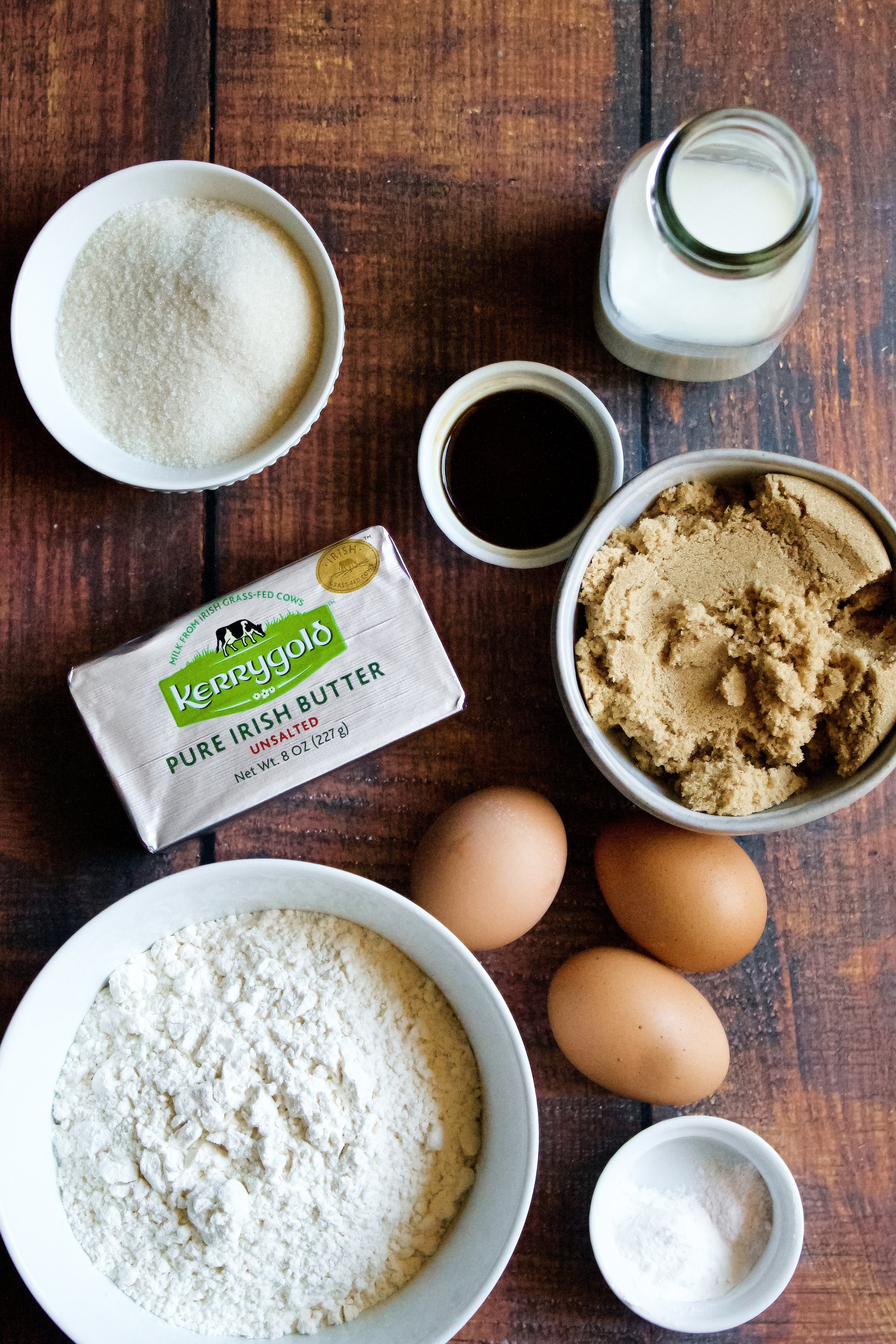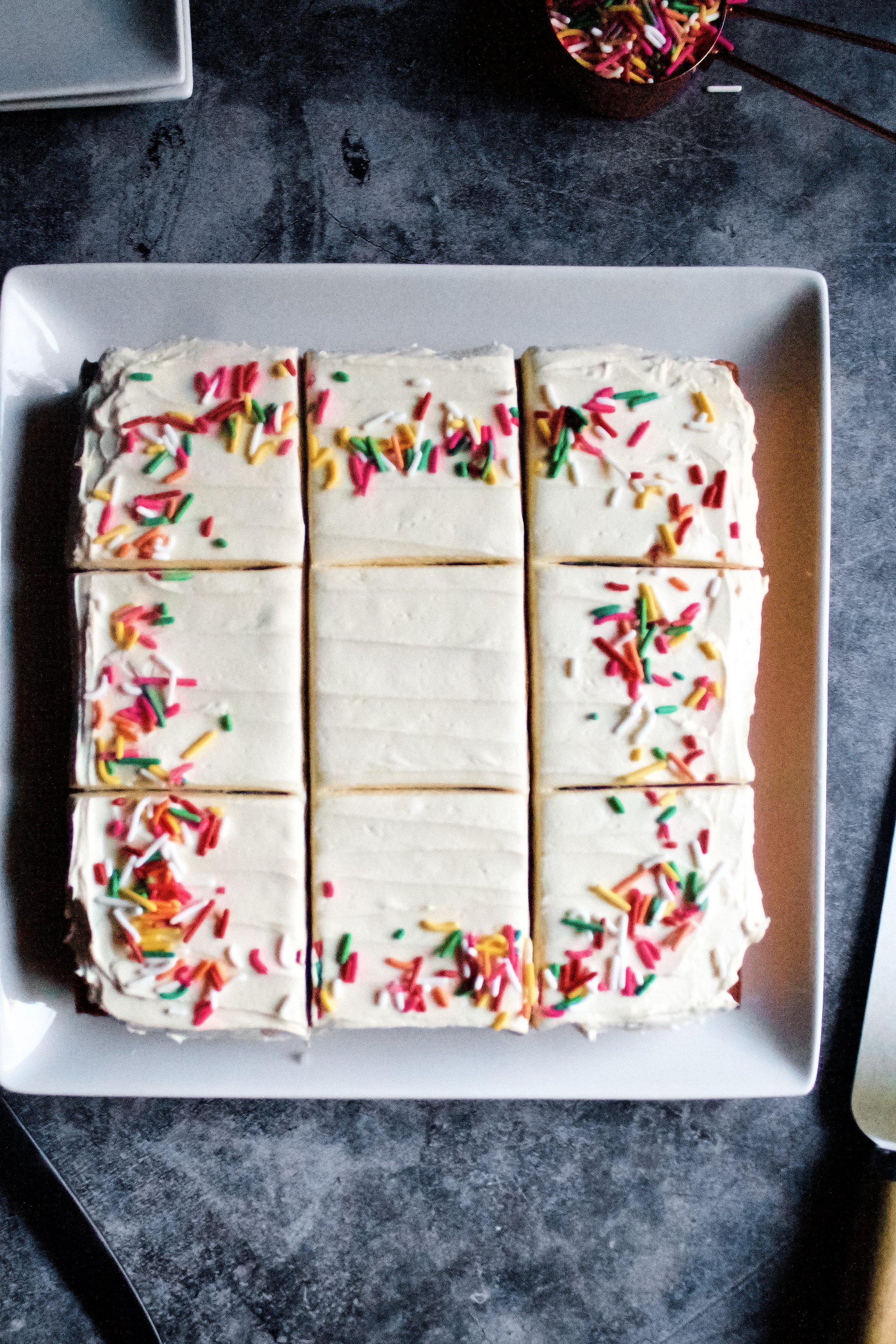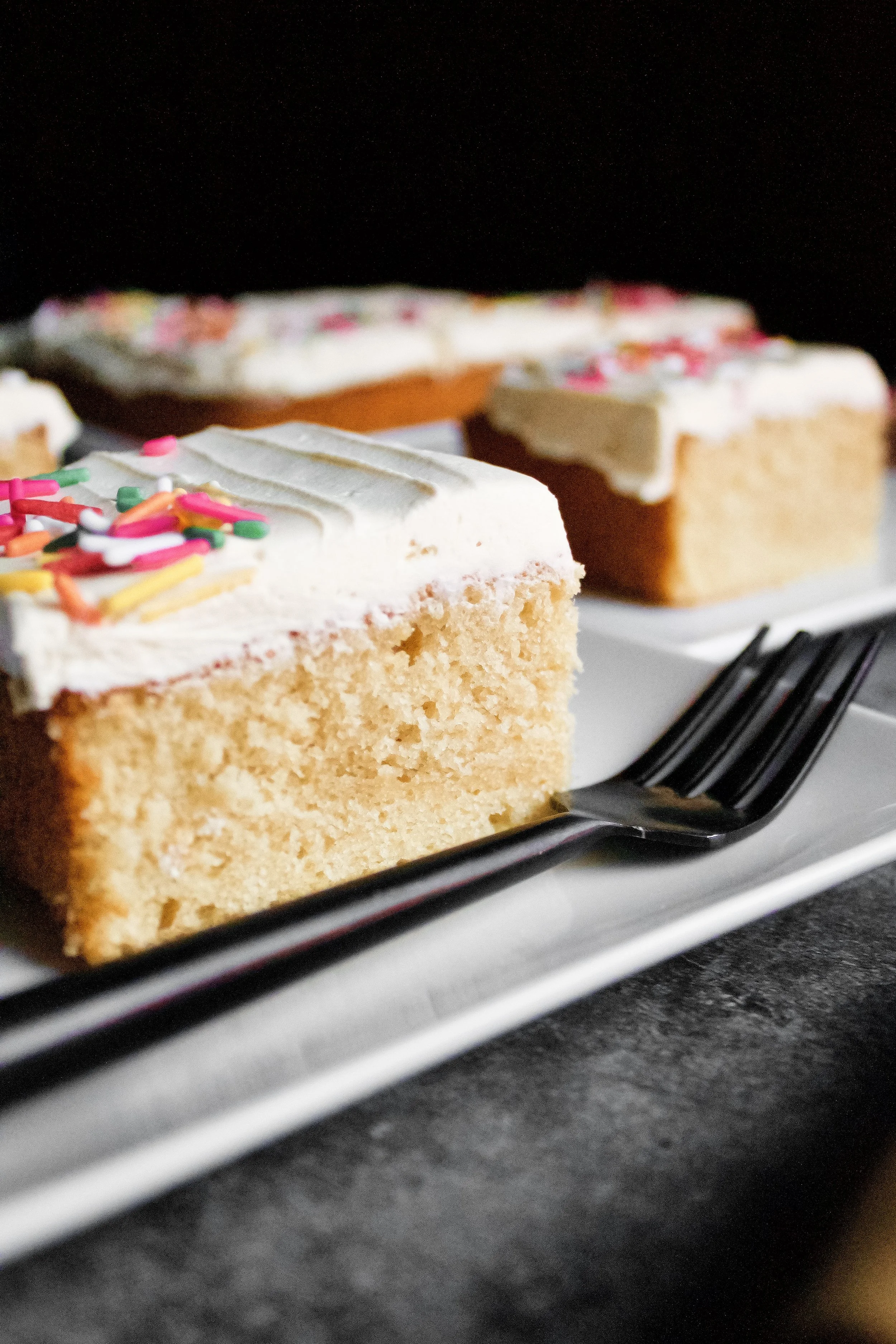Vanilla Butter Cake
Fluffy yellow cake that is full of flavor and can rival a boxed mix! This cake is light yet moist and has a perfect vanilla flavor. People won’t believe you made this from scratch!
This post may contain affiliate links from which, at no additional cost to you, I may earn a small commission to keep this site running. Only products I myself would or do use are recommended.
Guys. We are now in the fourth week of school and I’m still waiting for something crazy to pop up. Some big trouble maker that drives me crazy or a class I can’t keep focused. Instead, they’re all wonderful. The cynic in me says something’s up and they’re hiding it. The part of me that’s had a very tumultuous year (the anniversary of my brother’s passing—one of many family deaths we’ve had—is this Friday) is taking this small blessing and just appreciating it while it lasts (hopefully all year).
Despite the tough year, there have been positives. Some wins, even. Like this cake.
Ah, yellow cake. It has been my white whale. I make a mean chocolate cake. I’ve even had great success with olive oil cakes, denser Greek yogurt cakes, champagne cakes, spice cakes, eggnog and chai latte cakes, and even lemon cakes.
I’ve just never managed to make a plain yellow cake that’s as good as the boxed kind. I have tried and experimented with various recipes for years, always getting something too dense or too dry. Ugh. It’s just seemingly impossible to get it as fluffy and moist and (I hate to admit) flavorful as a boxed cake.
But the homemade, from-scratch baker in me just refused to admit defeat.
Which eventually led me to this cake. Using my favorite cakes as inspiration, I found a few key factors that make this cake light and fluffy yet still moist and perfectly flavorful.
White whale: you’ve met your match.
Why this recipe works
The use of cake flour is key in this cake. You can use store bought or make your own (see note below). It’s lighter and lower in protein, making it ideal for more tender desserts. Another key factor is using both European style butter (for the fluff factor) and a tiny bit of oil (for moisture). Using all oil yields a delicious, super moist cake, but it’s just never as fluffy as those boxed kinds (even though the stupid boxes call for using nothing but oil, which is just some kind of trickery in my opinion…but I digress…). So, beating butter and sugar gives that ideal fluff and adding just a bit of oil helps retain moisture.
Another interesting factor is that I used both granulated and brown sugar here. Brown sugar just gives such a deeper, almost caramelized flavor. Plus, it adds moisture! Win-win! Along with the brown sugar, adding more vanilla than your average recipe is key in making this cake so flavorful. You need at least a tablespoon before you get any real flavor.
Altogether, these small tweaks are what makes this cake such a winner!
Key ingredients
Cake flour. You can make your own. For this recipe, you’d want to use 4 1/2 tablespoons (1/4 cup plus 1/2 tablespoon) cornstarch and add that to 1 3/4 cup plus 1 1/2 tablespoons flour. Sift and whisk twice before using in the cake.
Baking powder. Be sure it’s fresh—not open for longer than 6 months (regardless of the expiration date on the box).
Salt. Sea salt is ideal.
Butter. European butter is best for this recipe, as it has less water.
Sugar/brown sugar. Using both adds a bit more flavor and moisture, without making the cake dark.
Eggs. Use fresh, large, room temperature eggs.
Oil. Just a tiny bit of oil (avocado, grape seed, or canola) helps keep this cake moist.
Vanilla. Use pure extract, not imitation.
Whole milk. Whole milk will make a better cake.
Vanilla buttercream. You can use any frosting you’d like, but I think this cake is perfect with classic vanilla. Chocolate is another great option!
How to make vanilla butter cake
1. Sift and whisk flour, baking powder, and salt.
2. Beat butter and sugars until light and fluffy. 2-3 minutes minimum on medium high. I usually beat it for about 5 minutes, because we use organic sugar that tends to take longer to break down.
3. Beat in eggs, one at a time. Beat on medium 30-60 seconds after each addition.
4. Beat in oil and vanilla. Beat on medium 30 seconds.
5. Alternate adding flour and milk on low. Beat on low until mostly combined, with some flour still unmixed—the next step will take care of that.
6. Bake. Pour into prepared cake pan(s) and bake until a toothpick comes out with just some moist crumbs. I did a half recipe in an 8x8 pan for these photos, but you could also make three 6” layers, two 8” or 9” layers, or a 9x13 quarter sheet cake.
7. Make the frosting while the cake cools. You can also make this ahead and refrigerate for 1-2 weeks or freeze 1-2 months. Just let it come to room temperature on the counter for a few hours then beat with a hand mixer for about a minute to fluff it back up.
8. Frost and decorate as desired. I did a small snack cake for these photos, but you can decorate in any way you like.
Enjoy!
Tips and FAQ’s for this recipe
Make your own cake flour!
I often make my own, because it’s so easy. One cup of cake flour is just 2 tablespoons cornstarch plus 7/8 cup all-purpose flour. Our, in simpler terms, 2 tablespoons cornstarch scooped into a 1 cup measuring cup then you scoop enough all-purpose flour over that to equal 1 cup (be sure to level it off with the back of a knife). Or, for a more mathematically accurate option for this exact recipe: use 4 1/2 tablespoons (1/4 cup plus 1/2 tablespoon) cornstarch and add that to 1 3/4 cup plus 1 1/2 tablespoons flour. Sift and whisk twice before using in the cake.
Can I make this ahead of time?
Yes! Depending on my schedule, I almost always make the frosting at least a few days ahead, whipping it quickly with a hand mixer before using. For the cake layers, I often bake my cakes the day before I plan to serve them. I let them cool completely then wrap them well in plastic wrap (I know, NOT eco-friendly), leave them on the counter overnight, then decorate them the next day. If I’m planning a rather intricate or time-consuming decoration, I’ll decorate them the night before and either refrigerate them or leave them on the counter, depending on the type of frosting/filling as well as the location (in fact, for outdoor parties I often freeze the cake then keep it in the shade until serving, when it will have warmed up just enough to cut without melting). You can also bake the cake further in advance and refrigerate (well wrapped) it for 1-2 days or freeze it for up to a month, but this can dry it out a little. It’s actually more ideal to freeze a frosted cake, if you have room. Simply freeze it for an hour then carefully wrap the whole thing with a few layers of plastic wrap. Leave the plastic on while it defrosts to allow the condensation to stick to the plastic, not the frosting.
Spoon then level your flour
Don’t scoop your flour! I never knew this until I started blogging, but it seriously makes a big difference. You will end up with roughly 25% more flour than the recipe called for if you just doonk (official baking term right there) your measuring spoon into the flour container and scoop. Gently spoon your flour into your measuring cup then level it off with the back of a knife. Trust me! It makes a difference.
Can I use a different frosting?
Yes! I’ve made this with marshmallow frosting and it’s so very delicious but a little on the sweet side (which I love). Another classic combo is chocolate frosting. Beyond those options, you of course could use any frosting recipe you like, since vanilla cake pairs well with almost anything!
My cake tools
Here are my must-have tools I use for making this cake. Affiliate links provided.
All-rubber spatula (this makes scraping the bowl easier so the batter and frosting doesn’t get all over a wooden handle!)
Mesh sieve (because sifting is KEY for a fluffy cake)
Offset spatula for frosting
Vanilla Butter Cake
- prep time: 40-45 minutes
- bake time: 20-40 minutes (depending on pan size)
- total time: 1 hour, 25 minutes (plus cooling time)
servings: 12-16
Ingredients:
- 2 cups plus 2 tablespoons (244g) cake flour, spooned then leveled
- 2 teaspoons (8g) baking powder
- ½ teaspoon (3g) sea salt
- ¾ cup (170g) unsalted butter*, room temperature**
- ¾ cup (150g) granulated sugar
- ¾ cup (150g) light brown sugar
- 3 large eggs, room temperature
- 2 tablespoons (27g) avocado or vegetable oil
- 1 tablespoon (13g) vanilla extract
- 1 cup (240g) whole milk, room temperature
- one batch vanilla buttercream (or chocolate!)
Instructions:
- Preheat oven to 325F/165C (350F/175C if at high elevation). Lightly butter and flour one 9x13 cake pan (or two 8” or 9” or three 6” cake pans). You can also use baking spray instead. Line with parchment paper (or use silicone liners).
- In a medium mixing bowl, use a large fine mesh sieve to sift then whisk together cake flour, baking powder, and salt. Set aside.
- In the bowl of a stand mixer fitted with a paddle attachment (or a large mixing bowl with a hand mixer), beat the butter on high until fluffy, about 1 minute. Add the sugar and brown sugar and beat until light and fluffy, about 3 minutes. Scrape the bowl as necessary, at least once.
- Add the eggs, one at a time, mixing on medium until light and fluffy (about 30 seconds) and scraping the bowl after each addition. Add the vanilla and oil and mix on medium until well blended.
- Add half of the flour and mix on low until just barely blended. Add the milk and mix on low until just barely blended. Add the remaining flour and mix on low until just barely blended with some flour streaks still visible.
- Using a rubber spatula, gently fold in sprinkles until evenly mixed in. This will also help mix in the remaining streaks of flour.
- Pour into your prepared cake pan(s), filling about ⅔ full (no more than ¾ full). Bake for 35-40 minutes (20-25 if using three 6” pans and 25-30 if using 8” or 9” pans), or until a toothpick inserted in the middle comes out clean. Check early, as climate, elevation, and individual ovens can cause the bake time to vary.
- Let cake cool in the pan 5-10 minutes, then remove to a wire rack to cool completely.
- When the cake is cool, frost with vanilla frosting and decorate as desired. Alternatively, you can use chocolate for a classic yellow cake with chocolate frosting.
Enjoy!
If not eating right away, a fully frosted cake (or well-covered 9x13 cake) can be kept on the counter for 1-2 days, in the fridge up to 1 week (chill it then cover it well), or frozen up to 1 month (freeze for an hour then cover well with plastic wrap).
Keep a cut cake fresh by placing a piece of plastic wrap right against the cut sides then covering the entire cake well with more plastic wrap or in an airtight cake holder.
*I highly recommend European style butter! It has less water and makes a richer dessert.
**If your butter has become shiny or oily, put it back in the fridge for 5-10 minutes until it firms up a bit (not hard) and is matte in appearance.



















